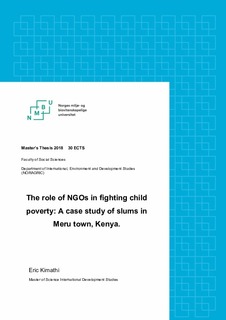| dc.description.abstract | In the last few decades increased attention has been focused on child poverty with robust policies and financial resources invested in the most vulnerable communities. This notwithstanding, children continue to experience deprivations in nutrition, education and healthcare and access to safe water which greatly compromises their growth and development and risks their future. While slum people are among those who suffer from extreme poverty, it is the children who remain the most vulnerable. The purpose of this study was to investigate the role of NGOs in combating child poverty in the slums of Meru, Town Kenya. The study adopted qualitative research method in a case study design and used both primary and secondary data sources for this study. The study had a sample size of 48 participants including 40 NGO beneficiaries, 6 NGO officials, and 2 county government officials. Semi-structured interviews were used to collect the primary data while secondary data sources included policy documents and newspaper articles. Study findings revealed that child poverty was not perceived any differently from poverty in general, but the participants focused more on elements of multidimensional poverty in terms of various aspects of deprivation. The study found that while the Kenyan government has a range of policies, there lacks a cohesive approach to work with NGOs while the current frame conditions for NGOs are enabling and restrictive at the same time. Moreover, the study found that NGO programmes are service driven towards the provision of education, health, micro-finance and cash transfers however they remain largely fragmented due to selective targeting of beneficiaries. The study found that NGOs are making a considerable contribution towards child poverty, however, their programmes are limited to a small population and not comprehensive enough to address structural elements of poverty. Besides, findings indicate that NGOs face challenges of non-cooperative beneficiaries and are perceived as elitist. The study concludes that slum child poverty cannot be addressed through increased service provision alone but rather via integration of provision and democracy-building through public participation, within a framework that draws the attention of the state to the social-economic and political exclusion of slum dwellers. The study further concludes that it is crucial for NGOs to explore the possibility to partner with the state in financing slums projects or possibly channeling their resources to the state to facilitate a more comprehensive approach to slum programmes. | nb_NO |

